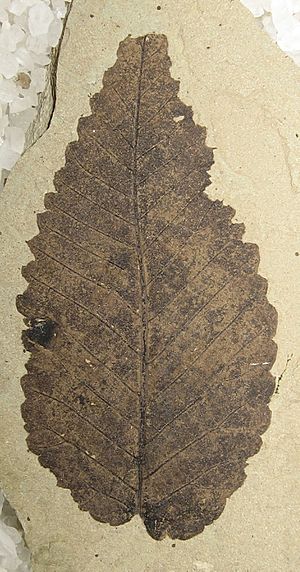Ulmus okanaganensis facts for kids
Quick facts for kids Ulmus okanaganensis |
|
|---|---|
 |
|
| U. okanaganensis sucker-shoot leaf | |
| Scientific classification | |
| Genus: |
Ulmus
|
| Species: |
okanaganensis
|
Ulmus okanaganensis is an extinct plant species. It belongs to the Ulmaceae family, which includes modern elm trees. Scientists know about this plant from fossil leaves, flowers, and fruits. These fossils were found in rocks that are about 49 million years old. They come from northern Washington state in the United States and British Columbia, Canada.
Contents
Discovering an Ancient Elm
Fossils of U. okanaganensis have been found in five places in Western North America. One main site is the Klondike Mountain Formation near Republic, Washington. This area is about 49 million years old. Other sites are in British Columbia, including One Mile Creek near Princeton, British Columbia, the McAbee Fossil Beds, and Driftwood Canyon Provincial Park. In 2009, more fossils were found near Falkland, British Columbia.
These fossil sites are part of the Okanagan Highland region. Most of them date back to the Early Eocene time period. This means they are very old, from a time when the Earth was much warmer.
In 1936, a scientist named Roland Brown studied some leaves from the Klondike Mountain formation. He thought they belonged to a different extinct plant called Zelkova oregoniana. Later, other scientists found more complete fossils. These included leaves still attached to branches with fruits and flowers.
Paleobotanists (scientists who study ancient plants) Thomas Denk and Richard Dillhoff carefully studied these new fossils. They realized these plants were different from what was first thought. In 2005, they officially described U. okanaganensis in a science journal. They named the species okanaganensis after the Okanagan Highlands. This region is where many of these important fossils were found.
Scientists believe U. okanaganensis is a type of elm. It is related to modern elms but is an older, extinct branch of the family tree. Its leaf shapes are similar to other ancient elm fossils found in places like Ellesmere Island and China.
What Did It Look Like?
U. okanaganensis was a tree with different kinds of leaves. Scientists have grouped the leaves into three main types. These types depended on where the leaves grew on the tree.
Different Kinds of Leaves
One type is called "sucker-shoot" leaves. These grew from new shoots coming up from the tree's base. They were the largest leaves, up to 130 millimeters (about 5 inches) long. Their leaf stalks, called petioles, were short and thick. The base of these leaves was often uneven, with one side larger than the other.
Sucker-shoot leaves had many veins, usually 12 to 14 pairs branching off the main vein. The edges of these leaves had "compound teeth." This means each large tooth had a smaller tooth at its base. The teeth usually had rounded, blunt tips.
Another type was "elongation shoot" leaves. These grew on the tree's regular branches. They were smaller, up to 80 millimeters (about 3 inches) long. Their petioles were shorter and thinner than the sucker-shoot leaves. The base of these leaves was usually only slightly uneven.
Elongation shoot leaves had a heart-shaped or ear-shaped base and a pointed tip. They had about 11 pairs of veins. The angle of these veins changed along the leaf.
The third type was "short-shoot" leaves. These were also 30 to 80 millimeters (about 1 to 3 inches) long. However, they were narrower, only 10 to 20 millimeters (about 0.4 to 0.8 inches) wide. They had 8 to 14 veins. The teeth on these leaves were "simple," meaning they didn't have smaller teeth on them. The tips of these teeth were usually pointed.
Flowers and Fruits
The flowers and fruits of U. okanaganensis grew in small clusters called fascicles at the leaf nodes. The fruits were small, only about 2.5 to 3.75 millimeters (about 0.1 to 0.15 inches) long. They had a short stalk, called a pedicel, up to 3.5 millimeters long.
Unlike many modern elms, the fruits of U. okanaganensis did not have a surrounding wing. The styles, which are parts of the flower that become part of the fruit, were separate at the top of the fruit. Some modern elm fruits have fine hairs, but most U. okanaganensis fossils appear smooth. This might be because the hairs were lost before the plant became a fossil.

